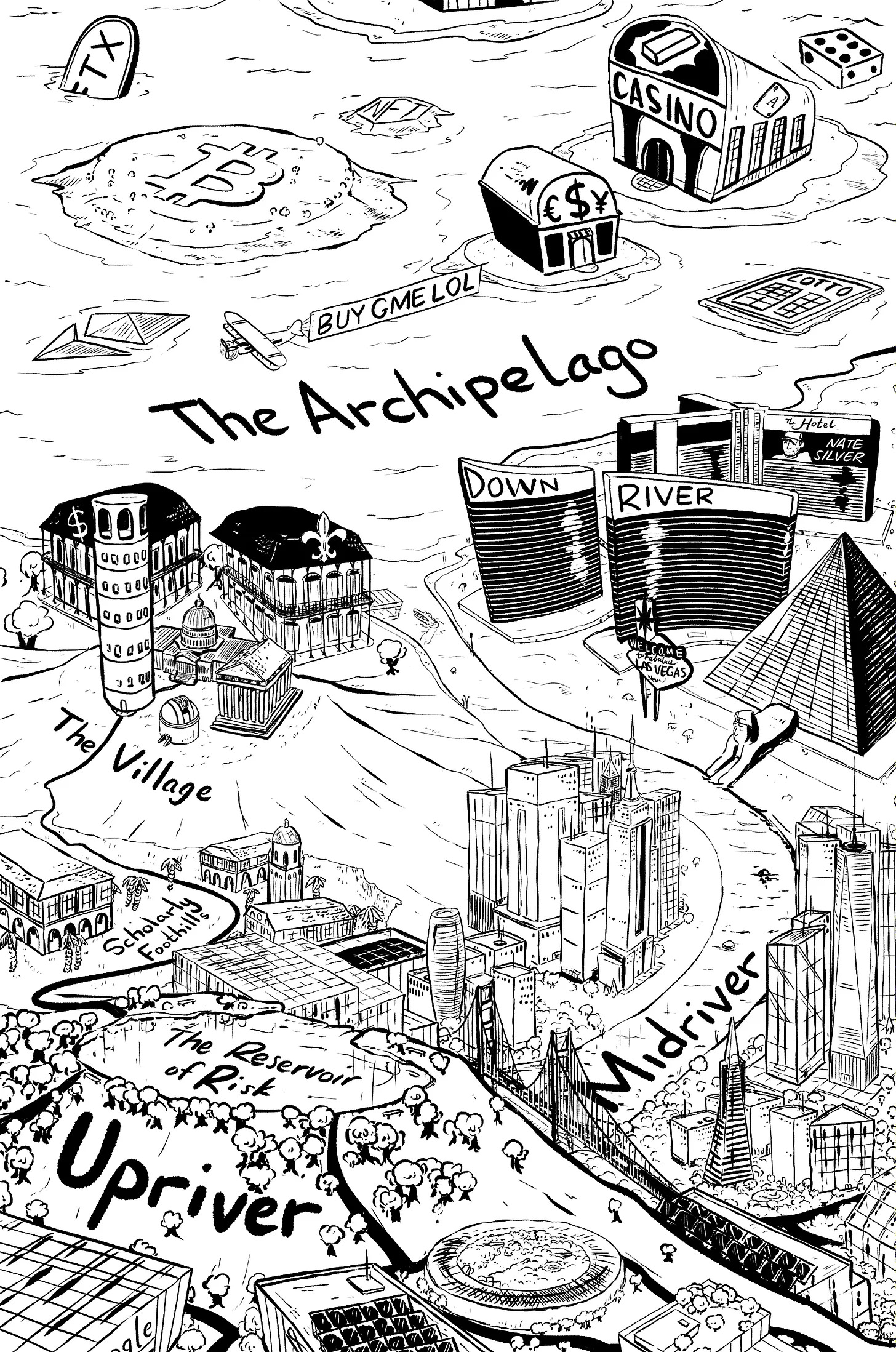On The Edge: a Riverian memoir written for the Village
A review of Nate Silver's latest book "On The Edge"
Who is Nate Silver?
You probably remember Nate Silver from 2012 when he correctly predicted the Electoral College outcomes of all 50 states and shot to fame as a public election forecaster. The general public glorified him then, treating his word as gospel truth.
You might also remember that his model in 2016 gave Trump a 29% chance of victory. Others had Trump much lower: for example the New York Times had Trump at 20%. But then again they also had a fake jitter on their real time prediction. Nonetheless, everyone pilloried him over “getting it wrong” in 2016, when he made a “damned good forecast” that, “if you’d bet on it you would have made a lot of money”. And yet people kept saying “Nate Silver is a fucking idiot” (this is a quote from his book).
But unless you’re subscribed to his Substack you probably haven’t heard from him for a while. And every four years everyone remembers him again when they think about US Presidential Elections, so this time he has written a book, “On The Edge”, to coincide with it.
The Village of the Book
This book is about many things, but the media around the book is really about one thing: the two rival communities he calls the River and the Village. So, let’s start there.
The River
Silver describes the River as a loosely connected group of people characterized by traits like competitiveness, contrarianism, “decoupling”, and risk-taking. They think both abstractly and quantitatively and make bets when they think consensus is wrong. They use so many phrases borrowed from Bayesian statistics and economics, like “update my priors” and “marginal utility”, that he felt the need to include a 25 page glossary of terms at the end of his book.
I should add here that as I read this, I imagined myself as part of this group. I am a quant researcher who worked at a trading firm for many years. My friends and family laugh at me for not translating out of River speak before I talk to them. I was enthralled by Silver’s first book when it came out. And, aside from the gamblers in the early chapters, I knew about all the people he interviewed and ideas he shared.
He also included a map illustrating the contours of the River, seen here:
The Village
I will let Silver describe the Village:
This term is more familiar: it’s basically the liberal establishment. Harvard and the New York Times; academia, media and government. The Village is politically progressive and, I would argue, increasingly partisan — though it can also be highly competent and it’s pretty good at winning elections.
This book is an introduction to the River, so he spends most of the book talking about the River and not much time on the Village. The Village seems pretty clearly defined from his quote above.
But the River?
What is the River again?
When I first read these I found the descriptions and delineations intuitive.
But as I reflected more, and despite all the words written about it, including by Silver himself, the concreteness disappeared. I couldn’t properly pin down the River as a group. I couldn’t work out who might or might not be in the River on the margins.
And I’m not the only one; Andrew Gelman also found it a strange model. He suggests one way to improve the model to include leading Republicans who fit into neither category easily:
define the Village as having left-of-center politics and then introduce a new entity—the Fort?—that has all the normie, risk-averse characteristics of the Village but on the political right. Ted Cruz and Samuel Alito are comfortably situated within the Fort
But I think I have a simpler description of the River. What ties all of the River together is, unsurprisingly, Nate Silver himself. He has personality overlap with everyone in the River. He chose to write about this group of people and to define the River.
The River is Nate Silver’s in-group and, crucially, the Village is the River’s out-group.
An in-group is exactly what you think it is: a group of people with a shared identity. What is an out-group? I’ll let Scott Alexander explain:
So what makes an outgroup? Proximity plus small differences. If you want to know who someone in former Yugoslavia hates, don’t look at the Indonesians or the Zulus or the Tibetans or anyone else distant and exotic. Find the Yugoslavian ethnicity that lives closely intermingled with them and is most conspicuously similar to them, and chances are you’ll find the one who they have eight hundred years of seething hatred toward.
That’s why Silver drew a detailed map of the River (intended as a quasi-self-portrait) and didn’t draw one of the Village. That’s why it doesn’t include Republican leaders — the River simply isn’t proximal to them. That’s why it is a little hard to identify who exactly is in the River from the outside.
The River of the Book
Which is not to say that the River and Village as concepts aren’t helpful outside of Silver’s book. Everyone he interviews — and he interviews over 200 people for this book — shares some aspects of personality with him. Sometimes it’s risk-taking, sometimes a it’s quantitative approach to problem solving, sometimes it’s taking a contrarian position.
Some of my favorite parts of the book were unusual Riverian observations about game playing that came up during his interviews.
Finding edge (ie finding a way to beat a system or a game on average) is often possible in real world situations. Expressing and monetizing edge is frequently the hard part. Casinos kick you out if you’re counting cards or playing the slot machines profitably (yes - you can apparently). Sports betting sites limit your bet sizes or ban your accounts if you’re deemed too good. Even if you forecast an election correctly, financial markets can not move after election events the way you think, as Jane Street found out to their $300m detriment.
Sometimes the optimal way to play a game is to deliberately introduce randomness. Remember that RockPaperScissors NYT online game that came out a while back that could.. just beat you quite consistently? Even though in theory the optimal strategy would be to randomly pick each time and you tried that for a while? It turns out that we are not particularly good random number generators, so a computer can pick up on our patterns. One way to introduce a better randomness into your play, as poker players sometimes do, is to look at the seconds hand on a clock. I love the fact that a random algorithm can be the optimal one, and that it’s very hard to find it within ourselves to be truly random.
The Kelly criterion as the formula for determining optimal bet sizing. Even though it appeared late in the book I think it’s one of the first things people should be taught about gambling. It is to bet-making what “Yes, and” is to improv. What “Hello, world!” is to programming. What “supply and demand” are to economics. You get the idea.
On The Edge as a Riverian memoir for the Village
We’ve already talked about some of the concepts in the book. Structurally this book consists of:
Four chapters about betting games
A halftime rundown of what it takes to succeed as a risk taker, and
A few more chapters meandering through Silicon Valley, Effective Altruism, online rationalists, and cryptocurrency
He claims they all share similar patterns of thought and so are cohabitants of the River. I claim more simply that the River is Nate Silver’s in-group. The Village, as the nearby group-with-small-differences, is his out-group.
If he had written a memoir in the Village-style, it would perhaps document his life as a gay man living in New York who had fame thrust upon him in his early adulthood. It would possibly reflect on the ups and downs of being a public intellectual. And it would probably precede a return to the more public life he lived prior to 2022.
If instead he had written a memoir in River-style, it would perhaps be an abstract tome full of probabilities and precise definitions. It would possibly talk about the ideas, decoupled from his identity, he has been thinking over in recent times, and probably where he stands on each.
This book is Nate Silver’s Riverian memoir written for the members of the Village. He talks about the ideas but also the people behind them and the stories he has along the way. Silver is very, very good at this.
If, from reading the previous descriptions, you don’t think you are a member of the River but you are reading this blog post, this book is probably aimed at you.
The Road to Edge Dorado
Nate Silver wants to show the world he is more than just a political forecaster so he has taken us on a tour of the ideas and frameworks and people he has been thinking about all his life.
Many of the communities mentioned in the book have risen rapidly to prominence and power over the last 20 years. Many have gotten obscenely rich. He writes this for an audience that is catching up to the immense wealth of this new group — his in-group.
If you are already well-versed with the groups and ideas described in this piece, the book won’t introduce you to much material you don’t already know.
However, if you hadn’t heard of the groups of people described in this review, and you care about who holds power now and who will in the future, this book is perfect for you. It throws a light on the people in the worlds that Silver inhabits. It explains how they think and how they communicate. (Did I mention the 25 page glossary of terms?). And it shows that he’s connected to them all in various ways.
Ultimately, he wants you to know that the River of Silver leads to oceans of gold.
Appendix: Silver’s Favorite Edgelord
Silver has a halftime listicle about what it takes to succeed as a risk taker which I found somewhat ham-fisted. He spends the subsequent few chapters detailing his interviews with SBF. These took place during and after the FTX implosion of November 2022.
In homage, here is my listicle about SBF, which roughly matches Silver’s. I came to the same conclusions from reading Michael Lewis’ Going Infinite, and from following the saga real-time:
SBF massively miscalculated his true risk
Linear utility of money is an almost surefire way to ruin, and
He probably did want to do EA-related good
I wasn’t sure why Nate included so much about SBF in this book except to provide a clear example of the hubristic failings of a prominent member of the River. The unwanted acne scar on the face of his self-portrait.






What is your p(doom)?